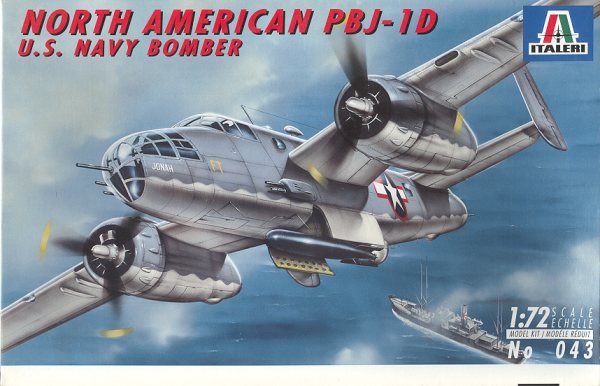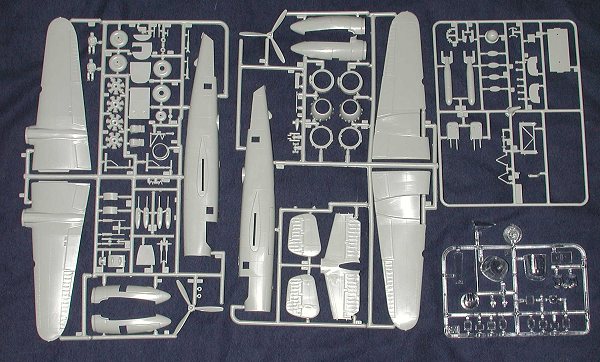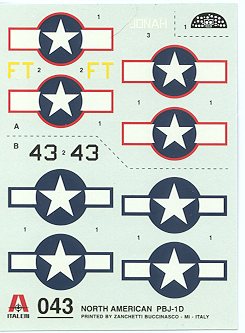
|
KIT: |
Italeri 1/72 PBJ-1D Mitchell |
|
KIT # |
043 |
|
PRICE: |
$14.00 |
|
DECALS: |
Two Aircraft |
|
REVIEW & |
|
|
NOTES: |
` |

|
HISTORY |
The best known US medium bomber of WWII has to be the B-25 Mitchell. Its use in the daring 'Dolittle Raid' of early 1942 is enough to indelibly etch it into the mind of those who are interested in aircraft. The fact that it was such a versatile aircraft has not hurt its reputation. It saw action in every major theater of operations in which the US participated. It was also used by a number of Allied nations during the war and even more countries after the war. In the US, it continued to be utilized in various roles until the very early 1960s.
One of the lesser known versions of the B-25 was the US Navy's PBJ. Actually, it was used more by the Marines than by the Navy. The Corps was looking for a fast land-based bomber that could also be used to carry a torpedo. The B-25D was the aircraft that was chosen to be modified for this role. In order to allow the PBJ to carry the torpedo with minimal modification, it was decided to hang it externally. To this end a framework was built to be installed in the bomb bay to carry the torpedo. The bomb bay doors were left in the open position while carrying the torpedo. While that did slow down the aircraft somewhat, by the time it was used in early 1944, aerial opposition had been reduced somewhat so speed wasn't that important. The Marines also added 'cheek' guns in a position further aft than normally carried by the Army. The plane was also modified to carry extra guns in the nose. Several PBJs were later fitted with a radar set that fit on the upper nose section and most carried a search radar that fit where the lower turret would have normally fit. This lower radar set could be retracted when not used.
John Lester sent in the following information on the PBJ
"While at least one PBJ-1D (the oft photographed "Jonah") was
modified to carry a torpedo, it was never actually used by Marine VMB sqdns in
combat. One sqdn on Oki modified their -Js with and external mount for carrying
two Tiny Tim rockets. The "pylon" looks like it was welded from rebar. It was
carried with the bomb bay doors closed. Not sure whether it was jettisonable,
but I have seen several pix of PBJs from that sqdn returning with bay doors open
- aired out the avgas fumes from the long range tanks held there.
Most of what saw combat were PBJ-1Ds and -Js. All these had radar - the D's
originally had these in a retractable belly mount, but most were modified to
sport them on the nose, over the bombardier's station (the "hose nose"
configuration).. -Hs and -Js came from the factory with the radar on the
starboard wing tip, but many were field modified to hose nose configuration
because the pilots liked it better.
-Ds were modified in much the same way as AAF -Ds were to carry extra defensive
fire power. By the time the -Js started reaching the fleet, they were having
guns (usually the top turret) removed to extend range."
Any other inputs??
|
THE KIT |

 The Italeri kit of the B-25
is not a new one, but is probably the best available in 1/72. This is despite
having been initially produced nearly 20 years ago. Despite its age, the molding
is in great shape as my example was pretty well free from flash and other
imperfections. The biggest problem I noticed is that the transparencies are not
in the greatest shape. Much of this comes from being tossed in a box unprotected
from rubbing on the other parts. Italeri does not bag its kits but just puts the
parts into the box and then seals the box. Perhaps it should reconsider this.
The Italeri kit of the B-25
is not a new one, but is probably the best available in 1/72. This is despite
having been initially produced nearly 20 years ago. Despite its age, the molding
is in great shape as my example was pretty well free from flash and other
imperfections. The biggest problem I noticed is that the transparencies are not
in the greatest shape. Much of this comes from being tossed in a box unprotected
from rubbing on the other parts. Italeri does not bag its kits but just puts the
parts into the box and then seals the box. Perhaps it should reconsider this.
The PBJ has several additional windows that need to be installed by opening holes in the fuselage. It also needs to have the bomb bay doors opened up to install the torpedo rack. In addition, the PBJ has a manned, unpowered tail gun positon that is a bit different from Army Mitchells. You get enough extra bits that you could do a normal B-25D, but in areas such as the ventral radar and tail gun position you'd have to do some extra work filling in the spots.
The kit instructions are very good and give color callouts using Model Master paints. These PBJs are shown as being sea blue over white, but I think they were painted in the tri-color scheme of dark sea blue, medium blue and off-white. When building this kit, I'd recommend doing research into that area. The markings are for two aircraft. One is a flight test aircraft with the red surround insignia. The other from VMB-413 in the Southwest Pacific. Both are circa 1944. The decals look a bit suspicious in terms of the national insignia. Not sure exactly what it is, but they just don't look right to me and I'd be tempted to replace them when building the kit.
|
CONCLUSIONS |
I have built several Italeri B-25s over the years and have been quite satisfied with the results. They may be 'old guard' but lack the fussiness of the new multiple variant kits that are currently the rage. Though there may be too many parts for the beginner, I'd recommend this to anyone who needs a decent 1/72 B-25.
Review kit courtesy of me and my wallet!
If you would like your product reviewed fairly and quickly by a site that averages thousands of visits a day, please contact me or see other details in the Note to Contributors.